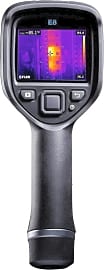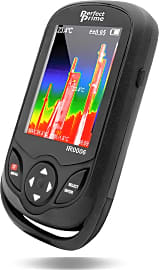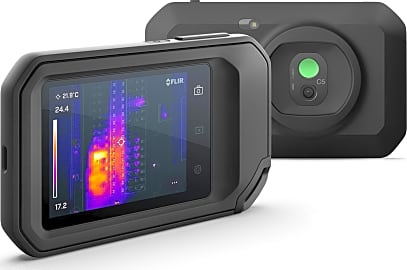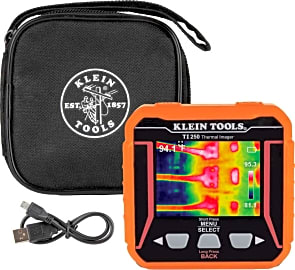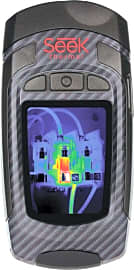The 10 Best Thermal Imagers

This wiki has been updated 39 times since it was first published in September of 2015. Whether a job requires searching for the source of heat loss, diagnosing the need for electrical repairs, scoping out wildlife, or finding the survivors of a collapsed building, something from our selection of thermal cameras and imagers can help. They are designed to make life easier for construction professionals, mechanics, engineers, HVAC technicians, and emergency responders. When users buy our independently chosen editorial picks, we may earn commissions to help fund the Wiki.
Editor's Notes
April 19, 2021:
When I first approached this update, and saw a list full of excellent options that were (almost) all still readily available, I was sure that this was going to be a fast and easy round of updates. But before long, due to an unusually large influx of new and upgraded models that became available over the last year, the situation quickly spiraled out of control and escalated to an all-out gut job. By the time we were done, the only options that ended up surviving our extensive renovations of these rankings were the Fluke Ti100 and Seek Thermal RevealPRO.
We scrapped the FLIR E75, noting that its recent discontinuation was leaving its availability primed for imminent expiration, and replaced it with its logical successor, the FLIR E76. We also replaced the FLIR E5 with the FLIR E8-XT – which features a better resolution and water resistance – and swapped out the FLIR C3 for the FLIR C5 — which is a better option in almost every measurable respect, from its temperature range to its thermal sensitivity. The FLIR Scout II 240 lost its place to the FLIR Scion, which costs considerably more but offers wireless connectivity via both Bluetooth and Wi-Fi.
Believing that these four choices meant that the company was already seeing a reasonable share or representation on these rankings, we eliminated the FLIR E8, which was suffering from some availability issues, and went on to replace the PerfectPrime IR0019 with the PerfectPrime IR281 – which offers better resolution. We also switched out the PerfectPrime IR0002 with the PerfectPrime IR0006 — which is one of the lightest options offered by the company, as well as one of the options offering the best field of view.
The Klein Tools TI250 clinched a spot close to the bottom of our list, as a budget-friendly model that may appeal to fans of the brand who are looking for a simple unit to handle basic tasks, and the Ulefone Armor 9 may just have became the most interesting option on our list — though not necessarily the most capable. A fully functional smartphone with an impressive IP69k rating that makes it ready to go to work in just about any environment, the Armor 9 is one of the only mobile devices on the market with an incorporated thermal imager. It boasts a 6.6-amp-hour battery and a 6.3-inch screen that’s double the size of many top units in this category. And, as an extra incentive for technicians who may be considering this phone as an everyday-carry gadget, the company also offers a endoscope adapter with an IP67 rating.
Notably, we removed the ATN Thor 4 this time around, because we felt like it was a bit of a miss for the category. But, if hunting is the name of your game, then you may find more options like that one on our list of thermal scopes.
January 03, 2020:
While brand variety is usually healthy, only a few brands in this niche really have any market pedigree, and are noteworthy in terms of their variety and quality of product options. These brands are Fluke Networks, FLIR and PerfectPrime (as well as Seek Thermal to a lesser extent, which fares quite notably with compact options and mobile thermal imagers).
I’ve done away with the Therm-App TA19A17Q, as I didn’t want to include any of the mobile-attachable thermal imagers/cameras because, while they are compact and cheap, they don’t offer as much quality as higher-end models – plus we already have a separate list for mobile thermal imagers.
I was, however open to including compact mobile-type (pocket) imagers like the Seek Thermal RevealPRO, as well as the FLIR C3. Both are good options, but the RevealPRO is slightly more compact and has a higher resolution, thermal sensitivity and a broader temperature range; while the C3 is slightly cheaper and gives you a larger screen, Wi-Fi connectivity and flexibility in image-orientation, among other things. The C3 is a notable improvement to the C2 in terms of image quality however.
I’ve also decided to leave a few of the thermal monoculars like the FLIR Scout II and ATN Thor 4, even though we have a seperate list for thermal monoculars. They don’t have the advanced features for reporting and data analysis that some of the other screen-display models have; but they are suitable for certain uses like hunting and animal-watching.
The FLIR E5 and FLIR E8 are both on opposite ends of the Ex-series model spectrum. FLIR makes some of the best handheld models around and the Ex-series has some really good-value-for-money options – better than equivalent Fluke models, in my opinion. By contrast, their Exx series contains professional models that are about as high-end as you get for a handheld imager, and naturally more expensive. I’ve included the FLIR E75 as a sophisticated mid-range option here. If you go through the specifications, you’ll really see a leap in thermal sensitivity, resolution and other features between high-end and mid-grade options.
Special Honors
FLIR T530 This entry-level model in FLIR's high-end T-series imagers is designed specifically for full-time professional thermographers, or for those who require a sophisticated and easy-to-use model to tackle everyday challenges in their line of work. While it has impressive specifications, like a 76,800-pixel IR resolution with IPS display technology, a Noise Equivalent Temperature Difference of less than 40 millikelvin and a reading accuracy of within 2% at lower temperatures, its most valuable feature is perhaps, like similar models, its 180-degree rotating optical block, which allows you to assess hot and cold spots, without having to constantly crane your neck. flir.com
Fluke TiX1000 With a 5.6-inch, 1024-by-768-pixel display and a generous 32x zoom (so you can capture the minutest temperature anomalies), as well as an in-software mode that doubles the resolution to a stunning 2048-by-1536-pixels, this is really a high-end model with an appropriate price-tag. Among its myriad state-of-the-art features, it offers multiple focus modes, including automatic, manual and EverSharp multi-focal recording which helps create detailed visuals by combining images from different focal lengths. fluke.com
FLIR K65 A suitable imager is an invaluable visual aid to firefighters, who need to quickly locate people trapped in a blazing fire and plan rescue routes according to hot spots. K-series models are specifically designed for fires, as they operate in low-sensitivity mode and allow you to clearly identify areas of lower temperature by not differentiating between temperatures above 650 C. They’re water-resistant, can withstand a drop, and can remain fully operational at 260 C for up to five minutes. flir.com
A Picture Really Can Be Worth A Thousand Words
The focused light is then scanned by the device's internal infrared detector elements, creating electric impulses.
Just as the microscope has allowed scientists, doctors, and researchers to perform cutting-edge diagnoses and to study both the structure and function of cells, so has the thermal imager expanded our capabilities with respect to identifying structural inconsistencies, potential problems, or variants using heat signatures. Regardless of whether you're a construction worker or an emergency responder, a thermal imager can keep you informed about your circumstances and even allow you to save lives.
Similar in shape to a camera, a thermal imager is a device that leverages infrared radiation to form an image from the simple measurement of small, relative temperature differences within and among objects. The imager detects these temperature differences and converts the otherwise invisible heat patterns into clear, visual data that can be seen through a viewfinder or monitor. While the device cannot see through walls, glass, or other solid objects, it can detect heat that has radiated toward the surface of those objects.
Using different infrared wavelengths, the imager measures the thermal signature of a particular area ranging from anything as small as an electric box to an object as large as an entire building frame. The device then interprets the data it collects and presents it to the user as a colorized representation of the heated areas, making it easy to detect places of thermal variance. The device does not measure temperature directly, but rather, the energy that has radiated out from the presence of thermal variance.
The thermal imager includes a series of components that allow it to do its job. A special lens is used to focus the infrared light waves coming from all the objects in its view. The focused light is then scanned by the device's internal infrared detector elements, creating electric impulses. These impulses are then sent to the imager's signal processing unit, which ultimately translates the information into visual data for its display. The final result is a thermographic representation of the selected area, or in simpler terms, a picture showing the spectrum of heat signatures that a person couldn't ordinarily see with their naked eye. The spectrum appears as various colors depending on the intensity of the infrared emissions.
The device can use one of two different types of detector technologies to accomplish this, cooled or uncooled. Cooled infrared detectors are usually cryogenically cooled and contained within a vacuum-sealed case. This cooling is necessary for the semiconductor material that these types of imagers utilize to function. Depending on their performance level, most modern cooled detectors operate in a temperature range of between sixty and one hundred degrees Kelvin (converted to between -213 and -173 degrees Celsius or -351 and -280 degrees Fahrenheit). Without this cooling, the sensors would be blinded by their own radiation.
Cooled detectors offer improved spatial resolution due to their ability to function at shorter wavelengths. They are also typically smaller in size than the microbolometer elements of uncooled detectors. However, cooled infrared detectors are typically more expensive to maintain and require additional equipment and energy to operate, which makes them less practical than some of their uncooled counterparts. Imagers using uncooled thermal detection feature sensors capable of operating within ambient temperatures. When heated by infrared radiation, uncooled sensors operate through changes in resistance, voltage, or electrical currents instead of through the use of cryogenic coolers, allowing them to remain small and lightweight and making them easier to transport as opposed to those imagers using cooled detection.
Industry Matters
Thermal imagers have many field and industry applications, including use by the military, law enforcement, medicine, construction, and even for archaeology. That said, one's profession and reasons for using an imager will really help narrow down the type of device that will work best for a given application.
With such applications, the imager should have a relatively large liquid crystal display to spot structural inconsistencies quickly through the infrared spectrum.
The technology can be used to spot electrical issues or moisture leakage within large building complexes, which can be a valuable asset for building inspectors, construction workers, and those responsible for analyzing a building's structure. With such applications, the imager should have a relatively large liquid crystal display to spot structural inconsistencies quickly through the infrared spectrum.
The device can perform technical surveillance or assist with search and rescue operations, which can come in very handy if you're a police officer, firefighter, or naval officer at sea. If you're a veterinarian or doctor, an imager can assist greatly with medical diagnoses and spotting problems in your patients early.
A Brief History Of Thermal Imagers
The birth of thermal imaging technology has its origin as far back as the year 1800, when Sir William Herschel first discovered infrared. The first bolometer was invented in 1878 by Samuel Pierpont Langley with the ability to detect radiation from a cow from up to four hundred meters away. Langley's device was also sensitive to temperature differences of one hundred thousandth of a degree Celsius.
In 1929, a Hungarian physicist named Kálmán Tihanyi invented the first night vision electronic television camera for anti-aircraft defense in Britain. The birth of the thermographic camera is attributed to both the United States Military and Texas Instruments in 1947. Through the late 1950s and 1960s, a combined effort between Texas Instruments, Hughes Aircraft, and Honeywell companies lead to the development of single-element detectors designed to scan scenes and produce line images.
However, the military was still the primary source of benefit for the technology due to its sensitivity and cost. Civilian (or non-military) use of thermal imaging technology became more common by the 1970s. By the late 1990s, costs for uncooled thermal imagers came down dramatically, allowing the technology to proliferate into many other industries where it is still in use today.



